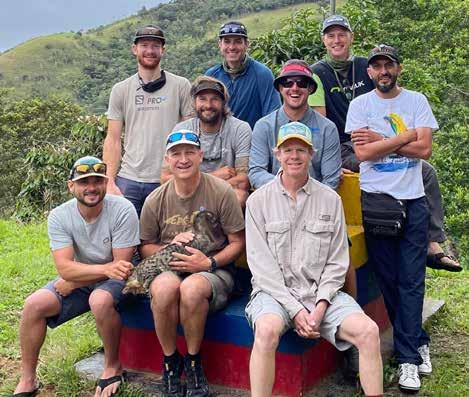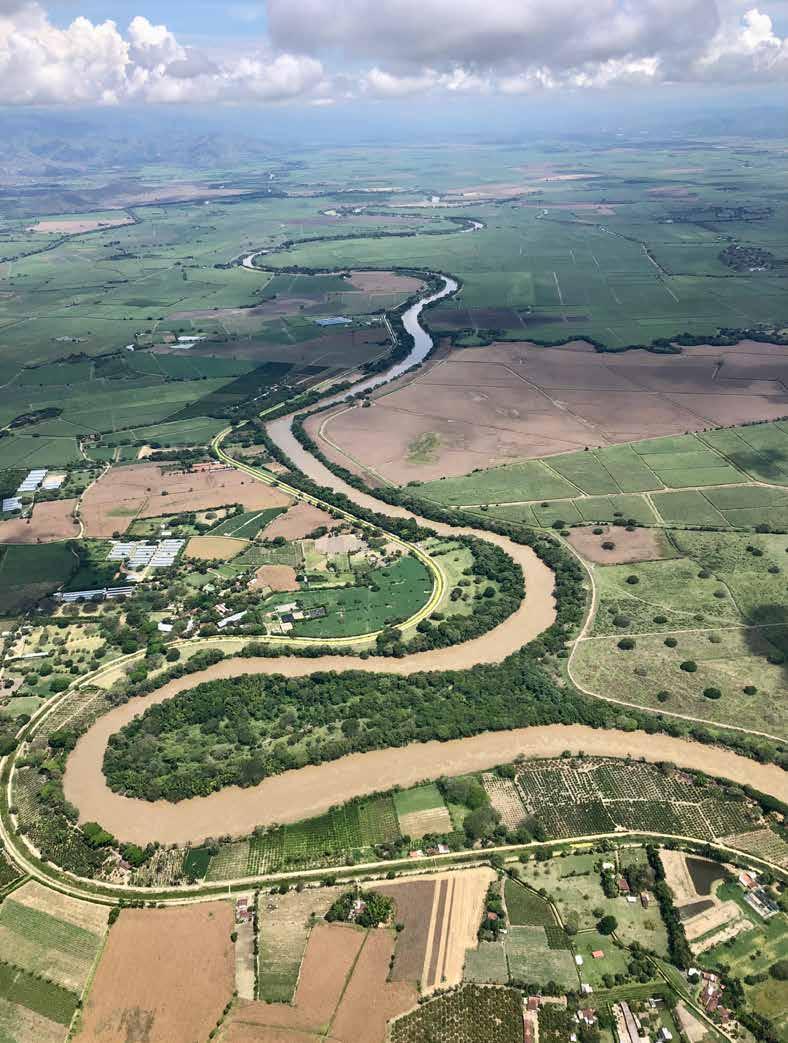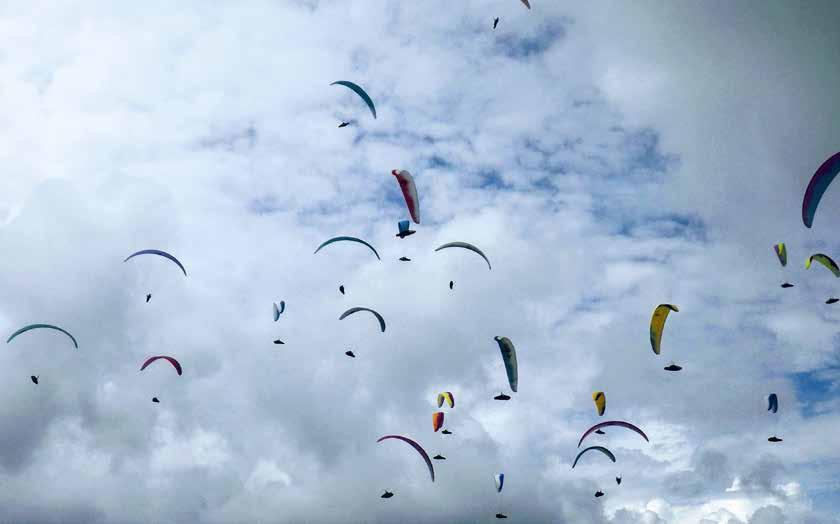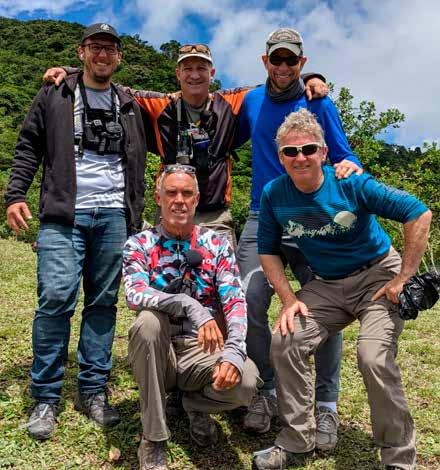
14 minute read
Columbia 2022
Personal lessons and advancements in the Valle del Cauca
by Angela BICKAR, OGNJEN GRUJIC, BENJAMIN SMITH, JOE POPPER
:In the winter of 2022, four of us (along with a few others) signed up with Eagle Paragliding for a memorable flying tour in Colombia. We had 7-14 days of flying with Rob Sporrer and his team of exceptional guides—Jeff Shapiro, Marty DeVietti, Reavis Sutphin-Gray, Austin Cox, Brian Howell, Logan Walters, and Chris Garcia. The tour included daily coaching, debriefs, and the opportunity for in-air coaching via XC tandems. Evening presentations covered thermalling, gaggle flying, weather, the mental aspects of flying, and more. We were learning all the time, everywhere—it felt like drinking from a fire hose! We all thoroughly enjoyed our experiences in Colombia and decided to collaborate on an article to
COLUMBIA

2022
Sunrise from the hotel. Photo by Joe Popper. Marty DeVietti kicking his eaglets out of the nest at the Los Tanques launch. Photo by Benjamin Smith.
share our highlights and key takeaways. Flying in the beautiful Valle del Cauca and landing between vineyards, sugar cane, and corn fields was an incredible experience. The locals were friendly and always there to welcome us with big smiles and offer us a ride back to the hotel. We also enjoyed connecting with unique, interesting people

Eagle Guides (first bottom, left to right: Austin Cox, Marty DeVietti, Brian Howell, Jeff
Shapiro, Chris Garcia, Flaco, Logan Walters,
Reavis Sutphin-Gray. Photo by a local.

and making new friends on the tour. Flying-wise, we all made significant leaps in our progression. We flew long and far, became more efficient at thermalling, got comfortable with landing out, and reached our personal bests.
However, each of us also faced a personal struggle that affected our flying. Our sport is incredibly mental, and for many, the psychological aspects of our sport are the most challenging components to master. A big part of the Colombia tour was dedicated to the mental aspects of flying—this was where the Eagle crew truly excelled.
The four of us combined efforts to relate our personal mental struggles with flying, how they affected our flying and progression, and how we overcame or worked towards overcoming them. We each had a great experience working with our Eagle instructors and the incredibly supportive community of pilots with whom we had the pleasure of spending the tour. We hope the community will find our stories insightful, relatable, and, for those who face similar struggles, helpful in overcoming them.
Ognjen Grujic
Personal challenges: task overload, motion sickness, positivity Throughout my flying career, I have faced many obstacles that hindered my progression. The one obstacle I have struggled with most was air sickness which always set in at about 45-60 minutes in thermic air. It prevented me from truly diving into the XC game for a long time. I tried it all! I stopped drinking alcohol, made sure to get a good eight hours of sleep, and I drank three liters of water a day to avoid dehydration. While the problem became less severe, it did not disappear. I started to believe that the problem was physical and that there was nothing I could do to entirely overcome it.
I went to Colombia with a lot of excitement but also with a ton of fear. I worried I might have to cut my flights short due to air sickness and would miss out on perfectly flyable days.


Throughout the clinic, the Eagle instructors talked a lot about the importance of being positive, having a good attitude, and being kind to oneself. Most importantly, they shared their personal struggles with flying and the mental tricks they used to overcome them. I loved what I was learning, and it helped me grow tremendously. One of the key takeaways for me was the importance of a positive attitude and self-talk, especially when the monkey brain turns on in rough air. Toward the end of the first week, I got a chance to put this advice to good use. The air got rough, the monkey brain wanted me to land, and I could feel some mild motion sickness setting in. I calmed myself down by deciding to postpone landing for another 45 minutes. With some calming thoughts and self-talk, it worked! The air sickness did not get worse, and I continued flying.
I took one thermal after the other and ended up on the other side of the valley. A glance at my watch revealed that I was way past the 45 minutes I had promised myself. Soon after, things got rough again. I got low with a few landing options and started overanalyzing the landings with respect to a potential retrieve. The air sickness got to me super fast. I threw up over my shoulder and landed soon after. Even with this rough ending, I was shocked to see that my flight had lasted 2 hours and 38 minutes, my new personal record.
Evidently, my motion sickness problem was not physical—I took control of it with a positive attitude and self-talk. Towards the end of the clinic, after many discussions with the instructors, I realized that several factors contributed to my issue. I suffered from self-induced task overload, and my motivation for flying focused too much on the numbers game rather than the journey and the joy of flight.
Identifying the core of the issue helped me to resolve it quickly. I started flying with a big smile and enjoyed every second in the air. I started seeing each flight as an adventure, no matter how long it was. I also saw my progression as a journey rather than a competition. Following this experience, I had multiple long flights without air sickness, but I also had three consecutive days of sledders that I loved. The third one was particularly memorable with a beautiful onehour hike out. I crawled under a barbed wire fence, jumped over streams, and hiked through the fields.
The new me enjoyed it all, while the old me would have kicked the rocks and felt bad because of the sledder. Positivity works!

Pilots Jeff Shapiro and Charles Chaffee walking past a sugar cane field after landing. Photo by Benjamin Smith. Cumulus clouds above and endless landing options below. Photo by Benjamin Smith.
LEFT: The hike up to launch. Photo by Joe Popper. RIGHT: The streets and surrounding hills of La Unión, a great place to find roasted chicken! Photo by Benjamin Smith.


Angela Bickar
Personal challenges: comparison, letting go of expectations, changing the narrative This trip was my second to Colombia with the Eagle crew. I love the tours because they enable me to surround myself with exceptional pilots and like-minded individuals. They challenge me to leave my comfort zone and make leaps in my paragliding progression.
I have been flying on and off for seven years, starting when my daughter was just a baby. I’ve had many memorable flights but also had some setbacks. My most significant setback was my reserve toss in June 2021 at Woodrat, Oregon. This was the first time it hit home that I was not invincible. It made me question why I fly and if the risks in this sport make sense for me as a mom. I am still working on rebuilding my confidence and bump tolerance.
I went to Colombia, anticipating this to be a challenge, but I was optimistic and still hoping for personal bests. However, the flights were not happening, at least not how I wanted them to. On day six, my teammate Ognjen and I landed early after a flight of only 12 minutes. I thought that by this point in the tour, I should be flying better, longer, and farther. As I was packing up my wing, tears filled my eyes. I felt impostor syndrome and was overwhelmed thinking about how everyone was progressing faster than me. I tried to heed the lesson that comparison is the killer of joy, but in the moment, it was difficult to rise above the emotions.
On our hike out, Ognjen reminded me that I could change the narrative. I took his advice to reframe the day and focused on the positives: I successfully parked the wing on a slope in a tight spot; I could celebrate a good launch, safe landing, and my growing confidence in landing out.
It was great timing that our guides, Chris Garcia and Marty DeVietti, gave a talk on the mental aspects of flying that evening. They emphasized a growth mindset: the belief that, with time, effort, and practice, we can improve. We can see challenges as opportunities to improve and use setbacks as a springboard to success. They also spoke about letting go of expectations and outcomes. Like flying the day and not the desire, Colombia was a reminder for me to let go of the pilot I was last
summer and to embrace the pilot I am now.
Many of the same themes are echoed in my guide Jeff Shapiro’s book recommendation: “Meditations” by Marcus Aurelius. “Meditations” led me to discover additional books on the wisdom of Stoic philosophy by Ryan Holiday: “The Obstacle Is the Way,” “Ego Is the Enemy,” and “The Daily Stoic.” When friends ask about highlights from Colombia, I share that I am most grateful for these transformative lessons that have given me a mindset that serves me well in paragliding as well as in my personal and professional life.
Benjamin Smith
Personal challenge: team flying is not for me, yet … Have you ever heard of a new pilot doubling their hours on a single trip to Colombia? That’s what happened to me this year. As a relatively new P2, I came into the 2022 trip with 18 hours, and I left with 36 and some new personal best flights. My goal for the trip was to get more hours, and I succeeded in that respect.
We received fantastic training from the Eagle instructors, and I valued all of it. But how could I apply those grand ideas to my beginner-level skills? Team flying, for instance, is an excellent concept that Eagle strives to incorporate in their XC teaching and radio coaching. When team flying, the more pilots you have sampling air, the greater the chance of finding the best lift. However, for this to work, you need everyone to stay together, flying at the same speed and altitude.
In Colombia, I tried to stay with the team, but I found myself repeatedly arriving late to the party, too low and too slow to hook in and get the next climb. I lacked the efficiency to keep up. It wasn’t until my second week in Colombia (I stayed another week after the Eagle tour) that I realized I didn’t necessarily have to leave the lift when everyone else did. Again, my goal for this trip was to get long flights, and after a few days of bombing out (and feeling
PWC pilot magic. Photo by Reavis Sutphin-Gray.

A gaggle of pilots working a thermal in the flats between La Union and La Victoria. Photo by Benjamin Smith.
angry), I realized I had to fly my way and at my speed. I discovered that I should do things like top out every thermal, keep recycling until I have someone (or something) marking lift for me, or even retreat to lift if nothing is developing out front. This strategy kept me in the upper half of the sky, where it’s easier to stay in lift. It started coming together for me on my last day in Colombia. I found myself deep over steep terrain, and I had not seen any other pilots for the better part of two hours—they had left me behind because I was recycling so much. After being on glide for about 10 minutes, I realized that if I didn’t find lift soon, I was looking at some challenging landing options. Everything below me was shaded out except for a cone-shaped hill next to a winding mountain road. The sun was illuminating this spot. It looked like a perfect little thermal trigger. I could imagine the lifting air dripping off of it. I headed straight for it, and voilà, I found lift. Though it was weak, I managed to gain about 500 feet before I spotted some birds and went to join their climb. Pretty soon, we were all skying out.
I allowed my wing to bite and steer toward the lift, and my vario sang. As I climbed, I found myself wondering where the birds went. I looked left, right, forward, and behind. When I finally looked up, I saw a big black bird soaring one meter above my wing, at the same speed, in the same direction, and maintaining an exact distance from my wing. We flew together for a couple of minutes before separating. What an extraordinary moment! There were no other pilots, just birds, finding a single trigger point above scary terrain. It was a magical day for me, redeeming all of the frustration and anger from the mistakes and bomb-outs of the previous days. I developed new strategies and regained perspective. At this stage, I’m trying to get long flights to build hours, and I need to stay high in the sky to give myself the best chance. In taking my time and flying at my speed, I am finding I can stay in the air a lot longer and discover things I couldn’t if I were trying to keep up with the team. I’m looking forward to the day when I have the skills to team fly and knock off big XC flights with others, but for now, I am content to fly slower and stay up longer.

Joe Popper
Personal challenge: focus on the accomplishments, not the perceived failures Colombia can be whatever experience you want. If you are a beginner, it is a great place to improve your skills and initiate the XC experience. For intermediate and advanced pilots, it is a place to go big. Valle del Cauca is huge, with opportunities to fly far in almost any direction. In my first year, nearly every flight was a personal best, with the next day being even bigger and better. My skills
were a bit off this year due to what I call COVID rust, but I still had an amazing time. The general progression of the day in Colombia was to launch around 10 a.m. into moderate lift. Launch sits at 5,300 feet, and cloudbase sits at 5,500-6,000 feet at that time of day. As the day progresses, base will slowly rise to 10,000-12,000 feet (on good days). During my trip this year, my max altitudes were 8,000 to 9,000 feet, and my flights averaged 2-4 hours. Others in my group got higher and flew farther. This year, it rained a lot in the morning, which made the early flying marginal, and I had several days where I struggled to stay up and find lift. On other days, I hung in with the big dogs for the whole day.
However, I spent too much time on negative thinking. I had several days where my group got low. I worked hard to focus on coring the thermal and flying where my fellow pilots were. Yet invariably, I would sink out, and the group would continue. This pattern continued enough that I began to give up sooner each time. When you are sitting on the ground watching your friends fly off, it’s so easy to become self-critical. I failed to focus on the other days when I would be the first to cloudbase and watch my friends catch up. I only focused on the negative and the self-criticism, and I didn’t take the time to recognize those accomplishments.
My fellow authors seemed faster at recognizing the need to be positive. For me, self-reflection happened during the writing of this article. I found I need to focus on the long list of successful accomplishments that occurred during an amazing flight and enjoy the journey. To put this in perspective, on a day where I missed a low save, I was joined on the ground by a highly rated world-class comp pilot who also missed his low save. It happens. Focus on the positive, learn the lesson of the day, and move past that negativity.
Conclusion In coming together to write this article, comparing our experiences highlighted our shared mental struggles. We learned that reframing our experiences positively and welcoming challenges enabled us to grow. The challenge and struggle keeps us coming back, and we are grateful for the journey.
Left to right, top to bottom: Ognjen Grujic, Marty DeVietti, Eric Kurzhals, Dave Pennington and Shaun Wallace.









